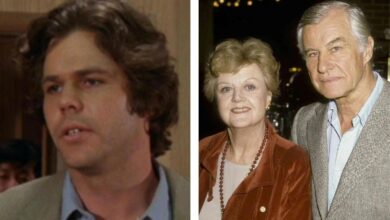What Really Happened to Barbara Roufs? Her Final Days Revealed
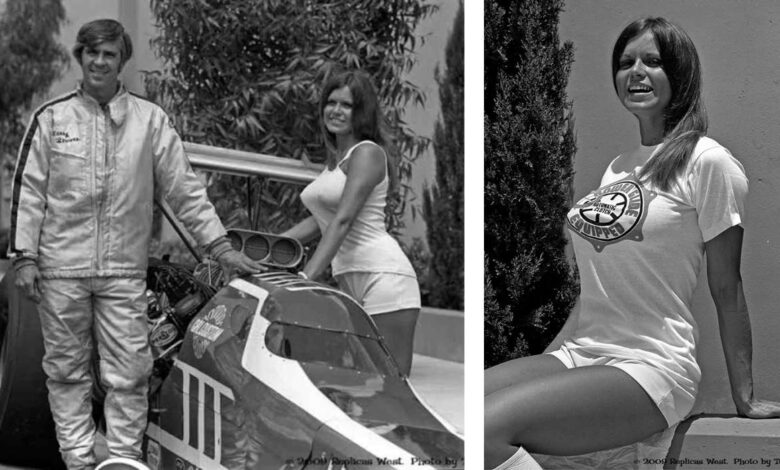
Barbara Roufs was a name synonymous with glamor, freedom, and the roaring culture of American drag racing during the early 1970s. With her flowing hair, magnetic smile, and iconic presence as a trophy girl, she captured the spirit of a generation defined by rebellion and the pursuit of speed. But behind the bright lights and roaring engines was a story with a darker ending—one that still leaves many fans surprised, confused, and emotional. In this article, we take a deep and respectful look into the life, legacy, and untimely death of Barbara Roufs, a woman who left an unforgettable mark on racing culture.
Quick Bio
| Full Name | Barbara Roufs |
| Nickname | Racing Trophy Girl |
| Birth Year | 1944 |
| Death Date | January 1991 |
| Age at Death | 47 years old |
| Cause of Death | Suicide |
| Birthplace | California, United States |
| Nationality | American |
| Ethnicity | Caucasian |
| Religion | Christian |
| Height | 5’5″ (165 cm) |
| Weight | 55 kg (118 lbs) |
| Body Measurements | 32-25-32 inches |
| Hair Color | Brown |
| Eye Color | Brown |
| Marital Status | Married |
| Daughter | Jet Dougherty |
| Known For | PDA Queen 1973, Drag Racing Icon |
| Net Worth at Death | $70,000 (estimated) |
The Rise of a Racing Icon: Who Was Barbara Roufs?
Barbara Roufs was born in the United States in the early 1940s, although exact records of her birth year vary. By the late 1960s and early 1970s, she had become a standout figure in Southern California’s drag racing scene. At a time when muscle cars, high-octane engines, and custom builds were becoming cultural obsessions, Barbara Roufs emerged as a trophy girl who embodied the glamorous edge of the drag strip. Unlike traditional beauty queens, she brought an edgy, rebellious style that reflected the freewheeling spirit of the times. Her tall figure, sun-kissed hair, and daring wardrobe choices made her an instant fan favorite among racers and audiences alike.
The Role of Trophy Girls in the 1970s Racing Scene
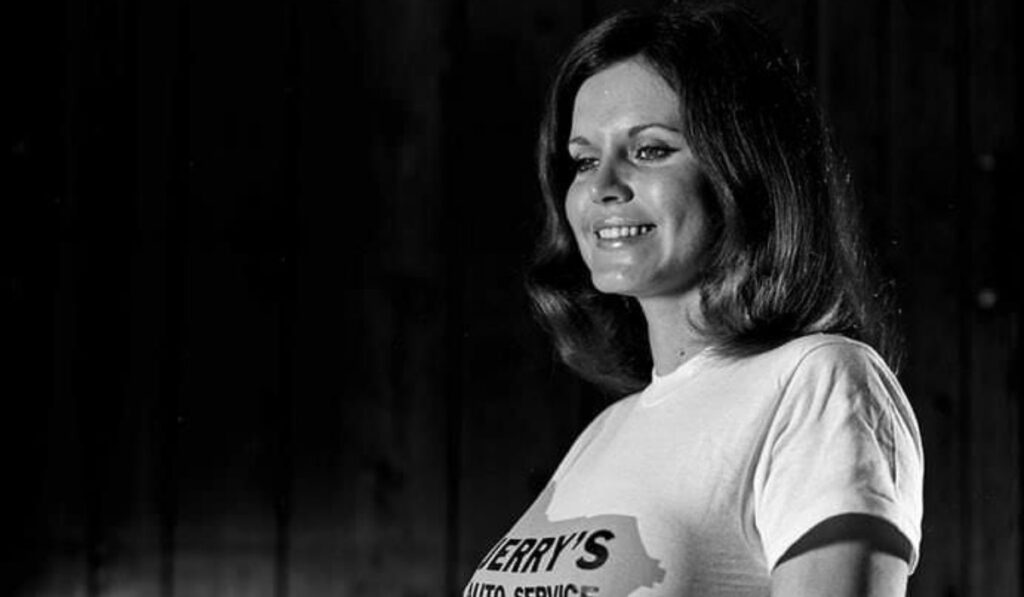
To understand the significance of Barbara Roufs, one must understand the role trophy girls played in the motorsports culture of the 1970s. These women were not merely ornamental; they represented the allure, fantasy, and emotional high that came with victory in a high-stakes race. In an era without Instagram or viral fame, drag races were live spectacles, and Barbara stood at the very heart of that drama. Her presence added an essential layer of charisma to the races. She wasn’t just standing by with a trophy—she was part of the atmosphere, a fan favorite, and someone who truly enjoyed the high-speed culture.
A Cultural Revolution in a Miniskirt
Barbara Roufs’ wardrobe pushed boundaries for the time. In an era when women were increasingly pushing back against conservative norms, she brought her own sense of personal freedom to the racetrack. Her flowing hair, high boots, short shorts, and tight halter tops weren’t just fashion statements—they were symbols of a cultural shift. This was a woman fully in command of her image, who wasn’t afraid to live on her own terms. She embodied the spirit of the California dream—sun-drenched, wild, and completely free. Barbara Roufs was not a background character in the male-dominated racing world. She was front and center, confidently owning her space and radiating energy.
The Sudden End of Her Career and Public Disappearance
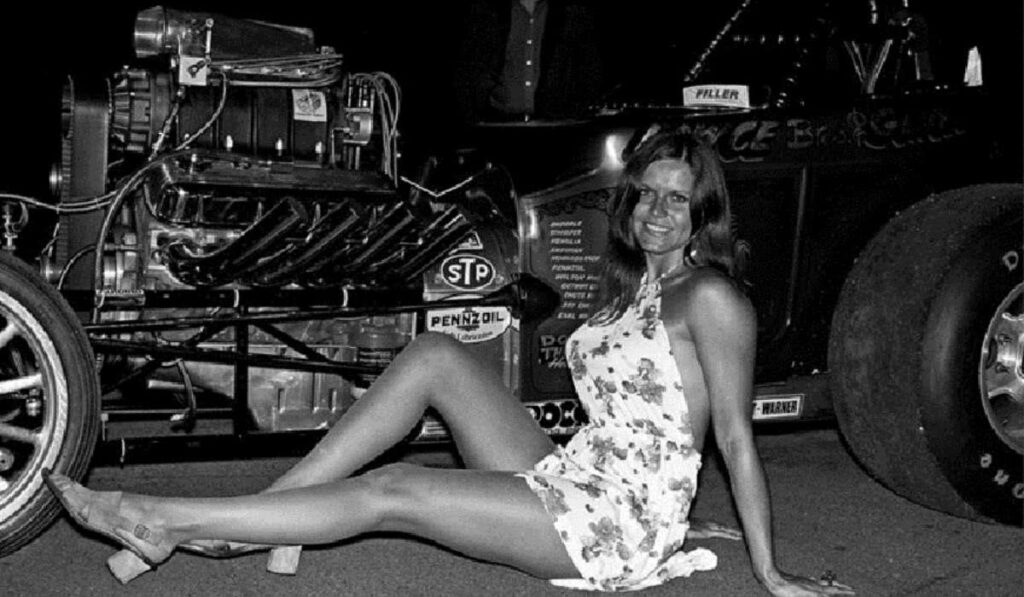
As the 1970s wore on, drag racing began to change, and so did public tastes. The PDA disbanded, and with it, many of the races that Barbara Roufs had graced came to an end. The shift in motorsports culture, as well as evolving expectations for women’s roles in such events, led Barbara to quietly step away from the spotlight. She stopped appearing at races, and fans were left wondering where she had gone. Unlike today’s celebrities, Barbara Roufs did not leave behind a trail of public interviews, blog posts, or social media updates. She simply disappeared from the scene, leaving behind only photographs and memories.
Life Away from the Cameras: The Private Years
Little is known about Barbara Roufs’ private life after she exited the drag racing scene. What we do know comes from the few friends and family members who have spoken about her in the decades since. She lived a quiet life, far removed from the roar of engines and cheering crowds. Sources close to her suggest that Barbara may have struggled with depression in her later years, although the exact circumstances remain largely private. Like many public figures who burn brightly and then fade into obscurity, Barbara Roufs seemed to vanish into the background of her own story. The silence around her only deepened the mystery and intrigue surrounding her life.
The Tragic Death of Barbara Roufs
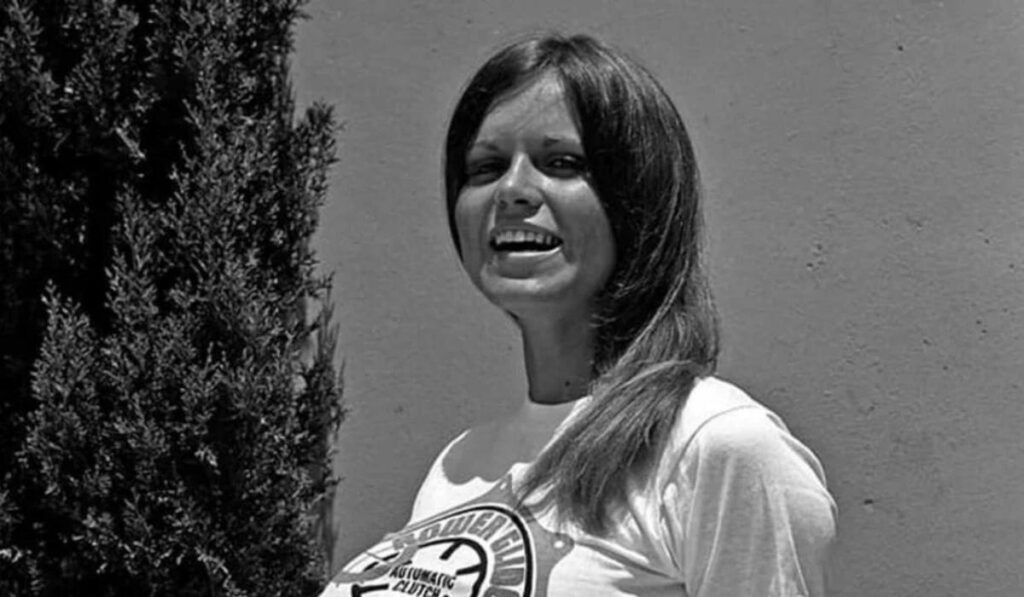
Barbara Roufs passed away in January 1991. According to public records and statements later revealed by her daughter, she died by suicide. The news shocked those who remembered her as the lively, beautiful face of American drag racing. The vibrant woman who had once stood proudly atop racing platforms and handed out trophies to victorious drivers had left this world in the most tragic of ways. Her death brought renewed attention to the pressures faced by women who once lived in the public eye and then struggled with private battles no one saw.
Uncovering the Truth Through Her Daughter’s Words
Much of what we now know about Barbara Roufs’ life and death came to light many years later, through a powerful series of photographs taken by a man named Tom West and shared online by her daughter. These photos, once hidden away, were posted on social media and quickly caught the attention of nostalgic racing fans and history enthusiasts. Barbara’s daughter offered rare and heartfelt commentary, describing her mother as a woman of beauty, kindness, and personal strength who had also faced many challenges. She emphasized that Barbara had been much more than just a “trophy girl”—she had been a mother, a dreamer, and a complex human being.
Why Her Legacy Still Matters Today

Barbara Roufs’ story is about much more than racing. It’s about the fleeting nature of fame, the societal expectations placed on women, and the emotional cost of living life in the spotlight. Her life remains a symbol of an era defined by freedom and rebellion, but her death reminds us that even the brightest stars can hide deep pain. Today, Barbara Roufs is celebrated not only as a symbol of the golden age of drag racing, but also as a woman whose story sheds light on mental health, identity, and the enduring impact of nostalgia. Her photographs still circulate across car enthusiast forums, vintage blogs, and racing history groups, where she’s remembered with admiration and sorrow in equal measure.
Barbara Roufs in Pop Culture and Online Tributes
Thanks to the internet and renewed interest in vintage Americana, Barbara Roufs has found new audiences decades after her death. Classic car blogs, retro fashion accounts, and drag racing history sites frequently post tributes to her. These online tributes help restore her legacy, not just as a visual icon but as a real person who was part of a larger cultural movement. Her daughter’s decision to share rare images and memories has given fans a fuller picture of Barbara Roufs—not just the woman in the miniskirt on the drag strip, but the human being behind the smile.
Conclusion: A Life Remembered, A Legacy Honored
Barbara Roufs’ life was filled with light, energy, and emotion. She was a pioneer in her own right—confidently striding through a world dominated by men, helping shape an unforgettable era of American motor culture. But her story didn’t end with a trophy or a cheer. It ended quietly, tragically, and far away from the cameras that once adored her. Still, her legacy lives on. By remembering Barbara Roufs honestly—with both admiration and compassion—we honor not just a beauty icon, but a woman whose story deserves to be heard in full. The truth of her life may be surprising, but it is also deeply human, and ultimately, unforgettable.
Frequently Asked Questions (FAQs)
1. Who was Barbara Roufs?
- Barbara Roufs was a famous trophy girl in the 1970s Southern California drag racing scene. She was known for her beauty, charisma, and embodiment of the free-spirited culture of that era.
2. What made Barbara Roufs so iconic in racing history?
- Her fashion style, vibrant energy, and groundbreaking presence as a trophy girl during the golden age of drag racing made her a cultural icon.
3. How did Barbara Roufs die?
- Barbara Roufs died by suicide in January 1991. Her death was revealed publicly years later through posts made by her daughter.
4. Is there any video footage or interviews of Barbara Roufs?
- There is very limited video footage available due to the time period. Most of what remains are photographs and written memories shared by fans and her family.
5. What is Barbara Roufs’ legacy today?
- Barbara Roufs is remembered as a symbol of 1970s drag racing culture, as well as someone whose story brings attention to mental health, identity, and the challenges of life after fame.



